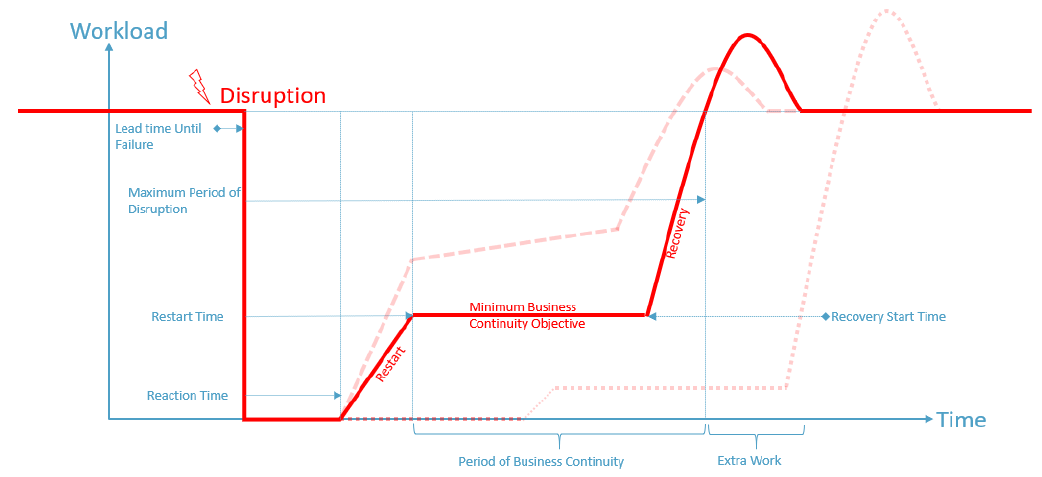Immediate Action Plan, Business Continuation, Recovery
Emergency management has its own vocabulary. The graphic from the BSI 100-4 Emergency Management provides a good overview of the chronological sequence. We explain this using a simple example:

You have planned a romantic dinner for your partner’s birthday and are sitting at home in your living room opposite the dinner table. Suddenly, all four light bulbs of their ceiling lamp fail. Unexpectedly you face a crisis. The time until you notice the failure is the detection time. Ideally, this time is short. A smoke detector, for example, has a shorter detection time of a room fire than your sense of smell when you sleep. So, you are sitting in a pitch-dark room. While you are still thinking about what to do, your partner has already pulled out the smartphone, switched on the flashlight, placed it on a glass and continues to eat dinner unaffected. Your immediate action plan should therefore be implemented within a short reaction time. A short reaction time is based, for example, on measures that are well trained in day-to-day practice. This immediate action plan consists of pre-planned measures that are implemented by those employees who are either on site at the fault location or who can initiate measures with little delay. You can feel your way into the kitchen using the flashlight app on your smartphone. Unfortunately, you no longer have spare bulbs in your house. Some time ago you read the flyer “Prepared for emergencies” published by the Federal Office for Civil Protection and Disaster Relief (Bundesamt für Bevölkerungsschutz und Katastrophenhilfe) at https://www.bbk.bund.de/DE/Service/Publikationen/Broschuerenfaltblaetter/Ratgeber_node.html and took appropriate emergency precautions. Only for this reason you have some candles in the house. You would call the selection of candles and matches as well as the insertion of candles into a candle holder a restart process. Your business continuation plan or emergency operation consists of replacing the function of the ceiling lamp with some candles. You will not achieve the same quality or quantity of light, but you will be able to continue your dinner in peace. Your partner will praise you for the romantic atmosphere. A crisis can also be an opportunity.
The emergency operating level can either be rising (if you light more and more candles during the course), constant, temporary (e.g. because candles are burnt down) or discrete (e.g. because you only light candles when you use the living room). The next working day you go to the supermarket and buy four light bulbs. The materials needed for the restoration, such as floor lamps or electrical testers, you still have to pick out. This recovery process should be planned and carefully considered. Next, you change all four bulbs and switch on the ceiling lamp. You now notice that the bulbs are not defective at all, but that a cable has come loose. Since you did not investigate the cause, your recovery process has become unnecessarily expensive. The repair is simple, but not harmless. Not only do you have to plug the cable back into the lamp with a screwdriver at a height of just under two metres, but you also have to make sure that your partner does not operate the light switch during this time. In this case, good corporate crisis communication is worth its weight in gold if you don’t want to be electrocuted. Once the repair has been completed, you will have more light than you need for a short period of time as well as some cleaning work to do. Do not underestimate this cleaning process, because while you are clearing away the ladder, you will see the mess in the storage room and the faulty electrical wiring there. Therefore, you decide to hire an electrician to check the wiring for further faults. You should also procure new candles to replace the used candles.
Together with the experts you can examine your risk, work out an application evaluation and develop suitable emergency precaution measures and emergency manuals for your company.
Contact us.






